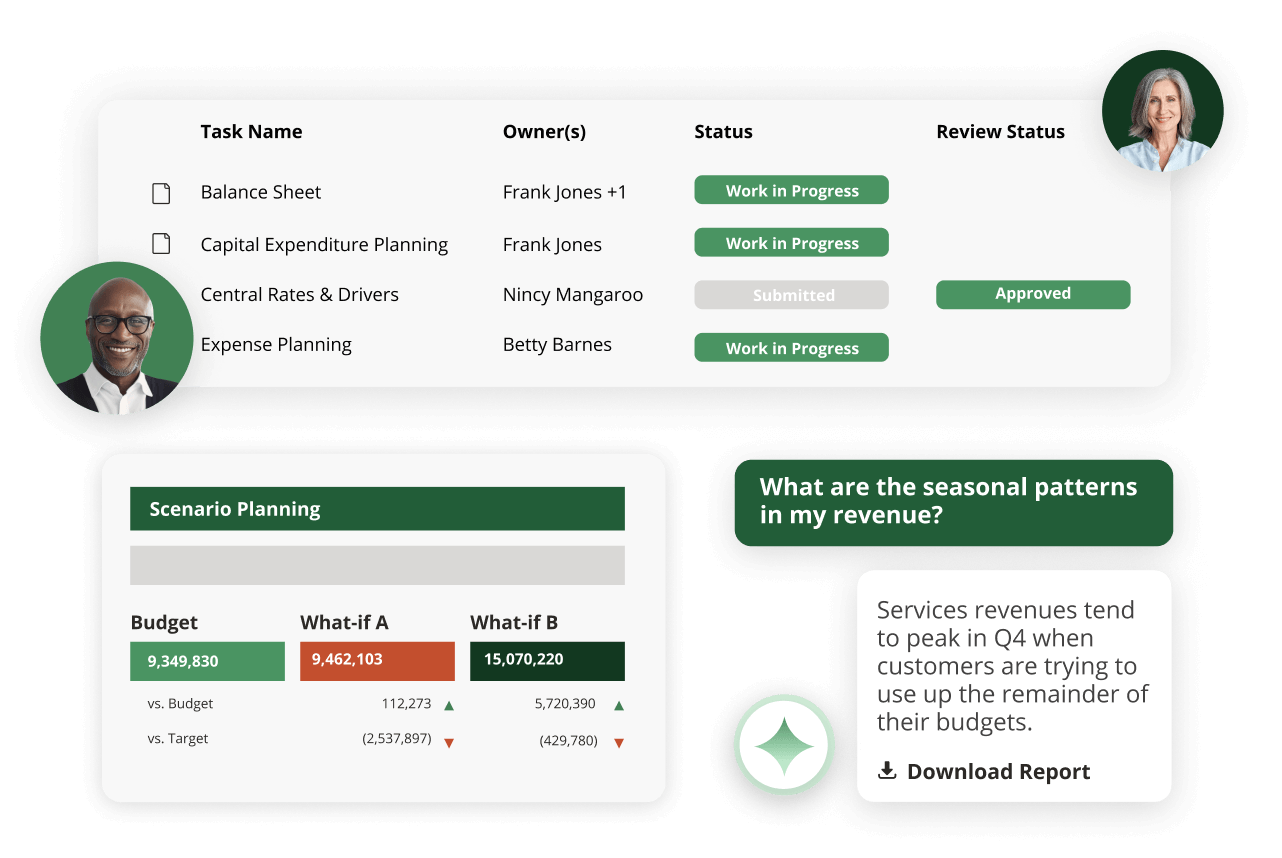You’ve made your decision. Signed the contract. Now it’s time to implement Vena into your business.
Implementing any enterprise software can be a large undertaking, often involving outside consultants and requiring close cooperation and change management across your team. For many businesses, that can mean weeks dedicated to setting yourself up for future success—and huge disruptions to your day-to-day workflows.
So we get it—you want to go in prepared.
And you want to reduce the disruptions as much as possible as you put in place your new corporate performance management software. It’s why one of the most common questions we get from new and prospective customers is: What does a Vena implementation look like? Another popular one: How long does it take to implement Vena?
In the sections below, we’ve set out to answer those questions—and to provide best practices for implementation that our team has collected over thousands of projects to set you up for success.
Keep reading to get the full scoop.
The Vena Implementation Process
We put a lot of care into ensuring our customers succeed in their adoption of Vena. And that starts with a successful Vena implementation.
After all, we know that when you focus on the wrong priorities, or implementation drags on longer than needed, it can be hard to build momentum and get your team excited about your new software investment. With that in mind, you want your implementation to achieve value quickly and get your team on board as early as possible.
Having a strong implementation plan at the start of your project will help achieve that. This is true no matter how you decide to approach your Vena implementation: on your own, with Vena’s help or by employing the assistance of one of our global consulting partners.
When working with Vena directly, you benefit from our professional services team, who have honed our implementation process across a wide range of customers and use cases. Here’s what it looks like:
Step 1: Initial Alignment
Understanding our customer’s needs and priorities is the first step of any implementation we undertake. We start by aligning with you to define your key priorities, high-level business requirements and source systems you want to integrate in the scoping process and Statement of Work (“SOW”) creation. When we begin the project, we’ll confirm whether these details have changed at all, as sometimes priorities change between when the project is mapped out and when we start.
Once everyone is aligned, we’ll flesh out a project plan and project timeline with your team, so everybody involved can hold themselves accountable to an agreed-upon schedule as the implementation progresses.
We typically recommend your Vena administrators plan to dedicate an average of 1 to 1.5 days a week of project time throughout the course of the implementation.
Step 2: Initial Product Training
Our goal in any implementation is to create in-house Vena experts. And that starts with product training for your power users.
We want to give the members of your team who will eventually take ownership of Vena the foundational knowledge they need to eventually train your end users. Self-paced e-learning and instructor-led training are the first steps towards this. Our Vena Academy was designed to provide this kind of learning to our customers—both new and old—and is a great place to start.
Continuous learning becomes a key part of implementing Vena, as your users collaborate with our professional services team.
Step 3: Data Alignment
For your team to successfully adopt Vena, it needs to be integrated closely with your data. That means aligning and configuring that data is a huge step to implementation success.
At this point in the project, we work with your organization to further define the required data sets for integration into Vena, and the process for integrating that data (i.e. direct connection with pre-built APIs, automated flat file, etc.), such as from your trial balance data and General Ledger (“GL”) transactions from your ERP or Accounting software.
Once the integration processes are configured, they can be automated and scheduled at a cadence of your choice.
Step 4: Workshops and Design
In addition to data alignment workshops, we'll dig deeper into your process and requirements in design workshops, resulting in a solution design document. Once aligned, we’re ready to configure your data models, planning templates, reports, security measures and workflows.
Ideally, your power users will work with us through this stage, so that we can build on their training and help them continue to learn how to use Vena in the context of your day-to-day needs.
This can also give your team a chance to think ahead about use cases you might want to add in the future. While use cases can be added to Vena at any time, having a clear sense of your long-term goals can help us design your Vena implementation with those future needs in mind.
Step 5: Configuration Review, Testing, End User Training and Signoff
Testing is a crucial part of our implementation process from start to finish. It’s the only way to understand if something’s going wrong before you go too far down the rabbit hole and need to backtrack to make changes—something that can cause delays in your timeline.
At this stage, we’ll allocate a few days to do a full system test. We’ll also get some of your end users involved in user acceptance testing before the solution is fully rolled out. Speaking of your end users, this is when we roll out training to them so they can get the knowledge they’ll need to use Vena confidently.
Once that is complete, your implementation team will sign off on the project. Now you’re ready to go live.
How Long Does It Take To Implement Vena?
But how long does all of that take?
The goal of any Vena implementation is to achieve value as soon as possible. But “fast” shouldn’t be your only objective—it’s more important that we build a quality foundation for your continued success.
The key to any Vena implementation is to find that balance between speed and quality. How long that takes will depend on the scope of your initial project and the readiness of your team and data.
To speed up your Vena implementation, while also ensuring you build the foundation you need, we recommend following the best practices outlined below.
With those in place, your Vena implementation can achieve value in as little as six to eight weeks.
7 Best Practices for a Successful Vena Implementation
To ensure your implementation remains smooth and on schedule, speeding up your time to value, we recommend keeping these seven best practices in mind:
1. Choose the Right Implementation Partner
While you can opt to pursue your Vena implementation on your own, we don't recommend it unless yours is a particularly small implementation with few complexities and you’ve already gone through a Vena implementation before.
With Vena’s professional services team or one of our many global consulting partners guiding you, your implementation will be smoother and those complexities easier to tackle. But it’s also important that you choose the implementation partner that’s right for you.
That’s because your implementation team is almost as important as the software itself in determining your future success. And our consulting partners and professional services team each have different specialties and knowledge that can aid your Vena implementation journey.
That might mean they have focused knowledge on specific industries (search for experts that specialize in your sector in our partner directory here) or have experience with different source systems or financial processes helpful to your business. Whatever the case, they can bring a deep understanding that meets your unique needs.
For instance, if you work for a small company with less mature processes in place, reengineering your processes and introducing industry best practices may be necessary. For that, you’ll want a partner with a depth of experience specific to your industry. They’ll be able to teach you how to configure Vena for your requirements and share tips they’ve seen work for other companies like yours.
On the other hand, if you work for a larger business with an experienced team and reliable processes in place already, it may be more important to instead prioritize finding a partner that can work with your robust data infrastructure and the scale of your project requirements, so that they can help you keep the implementation on track.
2. Don’t Try To Do Everything at Once
Don’t boil the ocean. That’s one of the first things we tell new customers. Trying to do too much at once can make it difficult to accomplish anything quickly, slowing down your time to value.
That’s why we advocate for starting small and using a phased approach instead.
With a phased approach, you can begin your implementation by focusing on a single use case or an initial problem you want to solve. This lets you achieve a quick win that will bolster your team and show them the value of Vena early on.
With that use case in place, you’ll be able to move on to the next phase, feeling confident in your continued success. Plus, by improving the efficiency of your operations in that one area, you’ll free up your team’s time to tackle more implementation phases faster.
3. Keep it Collaborative
As with any software implementation, there’s a spectrum of approaches you can take in your rollout of Vena. For instance, you may choose to rely on your consulting team or Vena’s professional services team to do most of your configuration for you. Or, you can opt to work closely with your implementation partner throughout the implementation instead.
A collaborative approach, where you work with your consulting team, lets your power users learn as they go, within the context of your unique processes and use cases. Through this collaboration, they can learn faster than they would if they tried to figure things out solely through more passive training.
Asking questions and learning best practices in this hands-on setting will help them teach your end users and enable them to add more use cases to your Vena instance.
This in turn helps create in-house experts and champions for the solution that will drive successful adoption throughout your organization.
It won’t just give you a better foundation to grow from, either—it will also reduce your total cost of ownership in the long run. After all, you won’t have to turn to Vena or your consulting partner for every new use case—you’ll be equipped to add them on your own.
4. Leverage Our Preconfigured Solutions
Why reinvent the wheel when you don’t have to?
With that in mind we have a library of preconfigured templates our customers can draw from. Taking advantage of these solutions means you don’t have to start everything from scratch, and you can speed up your implementation and achieve value from Vena faster.
These preconfigured solutions include templates designed for different use cases—such as financial close management, account reconciliations and financial consolidation, financial reporting, ESG, planning and reporting.
There’s also a library of industry-specific preconfigured solutions across areas like SaaS, banking, professional sports, not for profit and more. And finally, our Template Studio is another way to get started quickly, making it easy to quickly build custom templates tailored to your needs and ready for immediate use.
We recommend using these when you can, then focusing more of your time on the elements of your implementation that are unique to your business.
Take a guided tour of Vena's Template Studio, where you can build custom reports in just a few clicks.
5. Focus on Your Unique Needs
The power of the Vena platform is its flexibility and ability to meet your business’s unique needs. All of our preconfigured solutions can be further configured to meet those nuanced requirements.
And, our Excel-native interface means we’re able to leverage the existing Excel reports your team uses every day, only strengthened by Vena’s centralized database.
Take Citizens Advice, for example. They were able to implement Vena in a short amount of time, at a third of the cost of their previous system, partly because they could map out their existing workforce planning spreadsheet to their Vena database.
This flexibility is an asset during your Vena implementation, as we leverage both our preconfigured assets, your own Excel templates, and any new reports and processes you need to create a highly tailored approach specific to your business.
Because ultimately, we want to build a solution that works for you.
6. Have the Right Team To Support You
Having the right internal team to support your implementation journey is key to your success.
Here are some team members you’ll want to consider having on board for this critical project:
The Project Sponsor
Whether it’s your CFO, Vice President of Finance or another executive team member, you’ll want someone at the leadership level to champion your technology implementation. This will help ensure your Vena implementation gets prioritized and that the project moves along smoothly.
The Project Manager
Implementing a new technology platform can be a huge endeavor with a lot of moving parts. Having someone to manage all those parts will help ensure your project stays on schedule and budget, and that everybody’s doing their part.
The Process Owner
This is one of the most important roles you can assign during your implementation. As the person who manages the processes you’re trying to transform—budgeting or forecasting, for instance—they’ll work closely with Vena or your consulting partner throughout the implementation and continue as the system owner after you go live.
The End Users
These, of course, are the members of your team who will be using Vena throughout their day-to-day work. You should communicate with them throughout the implementation process, making them part of your ongoing implementation wherever possible.
The IT Team
You may also require some involvement from your data leads and IT team, specifically when it comes to two main areas:
-
Data extraction and data provisioning: A critical part of the implementation process is making sure we’re properly extracting data from your source systems and feeding it into Vena. But, before this is possible, IT may need to address any data quality issues first.
By involving each of these team members, you’ll ensure your implementation continues progressing swiftly, without any unplanned delays.
7. Communicate Early and Often
Finally, don’t wait until it’s time to go live to let everyone know a change is coming.
In our experience, sending an email a week before you deploy can put your team on the defensive. Instead, give them time to get used to the change. With a communication plan in place early on, you can use multiple channels to disseminate your message, introducing value-focused communications that will get users excited about the benefits Vena offers.
It’s best to not only communicate earlier, but also more frequently throughout the implementation to help get your team used to the idea.
We also recommend identifying and engaging the champions who will advocate for the software and build excitement for your target users. These are the team members who don’t resist change. Rather, they understand its value and encourage it among the rest of your team, building user acceptance.
A formal feedback process (for instance, a survey of your end users) can help as well. By incorporating your users’ feedback into your plan and introducing a culture of continuous improvement, you can involve everyone on your team in your ongoing Vena implementation.
The 5 Pillars of Vena Implementation Success
As with any software, if you want to integrate Vena successfully into your business processes, it’s important to get the implementation right.
But how do you know your implementation is going well while you’re still in the middle of it?
At Vena, we measure implementation success against these five pillars:
1. Are You Meeting Your Predefined Goals?
We recommend that every organization start their implementation with clear, achievable goals, then communicate them early. This lets you, your team and your executive sponsor clearly measure how you’re doing compared to where you want to be.
2. Are You Achieving Value Quickly?
When an implementation goes on too long before achieving value, team members can begin to feel disheartened, and you may lose momentum. The more manageable the phases of your implementation process, the quicker your team can begin to achieve value, building cohesion and contentment around the implementation project.
3. Are Your People Happy?
Everybody on your team has a full-time job with roles they’re responsible for on a daily basis. A technology implementation adds to those regular responsibilities. But by aligning your project needs with the appropriate skills and knowledge on your team—and ensuring everyone has enough time to accomplish their part—you’ll help ensure the implementation doesn't overwork or overwhelm them or make them resent the new software from the start.
4. Are You Collaborating with Your Implementation Partners?
Without a collaborative approach, you risk coming out the other side of your Vena implementation without the knowledge your team needs to set yourself up for success going forward. By involving your team and engaging your end users as early as possible, you’ll be in a much better place to take advantage of every benefit Vena offers.
5. Is Your Data Integrated and Accessible?
Data is the backbone of any Vena success story. That means it’s critical that all of your relevant data sources are integrated effectively with Vena and that there are no data interruptions. When Vena has real-time access to your source data at the level of granularity you require, you’re putting yourself on track for successful Vena use.
Setting up those data integrations correctly from the get-go will determine whether you get the full value of your FP&A software investment.
Set Yourself Up for Success
With all of these elements in place, there's nothing stopping you from implementing Vena successfully in your business. In no time you’ll be benefiting from the new tools it offers and empowering your FP&A processes and beyond.
And your initial implementation is just the start. With Vena now a part of your day-to-day processes, you can create a foundation of continued success that will allow you to keep adding value to your Vena usage for years to come.







